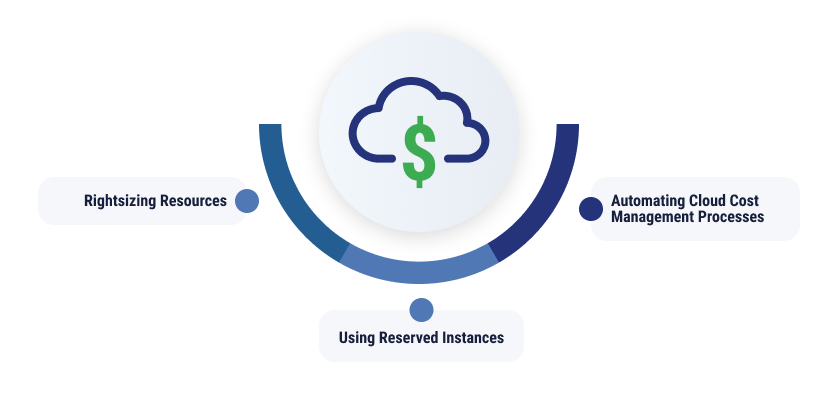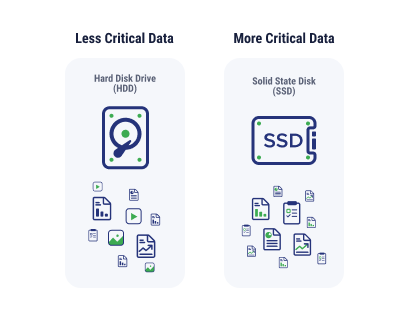
As businesses advance their digital transformation projects, cloud computing can unlock greater opportunities for scalability and innovation. However, the cloud can be used inefficiently without a plan and monitoring in place. We’ve included some best practices your organization can implement to improve your cloud efficiency.
What is Cloud Efficiency and Why is it Important?
Cloud efficiency is important primarily because cloud resources feel less tangible. When businesses focus on cloud efficiency, they’re striving to make the most of their cloud resources. It’s easy to end up paying for resources that aren’t being used, and cloud efficiency counters this by focusing on eliminating waste, optimizing performance, and improving agility, all while creating a more sustainable cloud environment.
The Impacts of Cloud Inefficiency
Cloud computing can improve scalability and efficiency for businesses, but it doesn’t come without its challenges. There are significant business impacts, as well as environmental impacts, to cloud waste.
Cloud bills can rack up if businesses aren’t paying attention to usage. Because cloud resources can be less visible, the strain on your budget can feel more subtle. Vendor lock-in can also leave organizations feeling stuck with their current provider without adequate leverage to renegotiate contracts.
Excess cloud resources can also cause performance drag and create unnecessary security vulnerabilities. Downtime and data breaches can not only be costly from a financial standpoint, but from a reputational standpoint as well.
Using unnecessary resources in the cloud can also come with negative environmental impacts. Approximately 3 to 4% of global emissions come from the digital sector, and that number is expected to double by the end of next year. High-performance computing, artificial intelligence, machine learning, and 5G connections will all contribute to this spike. Businesses that are able to streamline their usage will save money and improve their sustainability.
8 Ways to Improve Your Cloud Efficiency
When improving cloud efficiency, businesses may want to implement one or several measures to optimize their cloud environment and reduce the resources they’re using. Here are 8 ways you can start.
1. Implement Comprehensive Cloud Cost Management
By leveraging cloud cost monitoring and forecasting tools, you can gain real-time insights into your cloud spending with information on resource usage, trend predictions, and cost breakdowns.
Some cloud cost management techniques include:

- Rightsizing Resources: Real-time reports can help you ensure virtual machines, storage, and other resources are appropriately sized for your workload demands.
- Using Reserved Instances: Cloud resources can be purchased at a discounted rate with reserved instances. This can be ideal for predictable workloads but shouldn’t be used for usage that varies greatly.
- Automating Cloud Cost Management Processes: Automated rules can be used to scale instances based on predicted usage patterns and shut down idle resources. Businesses can also set up alerts for anomalies in activity.
2. Optimize Storage
Cloud efficiency can be improved via storage optimization, which can be done in a few different ways. One key strategy is implementing a tiered storage architecture, where data is categorized based on access requirements and stored on appropriate media types. Frequently accessed data should reside on high-performance storage like solid-state drives (SSDs), while less critical data can be archived on lower-cost options such as object storage or tape. This approach ensures that data is stored in the most cost-effective and performance-optimized manner.

Another technique for storage optimization is data deduplication and compression, which reduces the storage footprint and associated costs by eliminating redundant data and compressing files before storing them in the cloud. This minimizes the amount of storage provisioned and the data transferred over the network, leading to significant cost savings. Additionally, organizations can automate data lifecycle policies to transition infrequently accessed data to lower-cost storage tiers or archive services, ensuring that data is stored cost-effectively based on access patterns and storage resources are used efficiently over time.
3. Improve Cloud Operational Efficiency
Automating infrastructure provisioning and application deployment workflows can reduce costs associated with operations, decrease the number of manual errors, and improve consistency in the cloud provisioning process. Two strategies to improve cloud operational efficiency include incorporating Infrastructure as Code (IaC) and adopting an internal DevOps culture.
Infrastructure as Code
Infrastructure as Code (IaC) can be used to define a cloud environment using code. This approach unlocks benefits like version control, repeatability, and streamlined infrastructure management.
Adopt a DevOps-Centric Culture
Embrace a DevOps culture to bridge the gap between development and operations. This fosters seamless collaboration, allowing teams to continuously optimize cloud deployments, boost efficiency, and respond swiftly to evolving business demands.
4. Drive Cloud Performance and Reliability
When you’re monitoring resource utilization, you can use the information gathered to improve cloud performance and reliability. Regularly monitor resource utilization and application performance to identify potential performance bottlenecks.
Reliability is a big part of cloud resilience – ensuring that your cloud environment will continue to be operational after a disruption. Cloud-based disaster recovery solutions can provide comprehensive protection for your environment. After implementation, schedule times to regularly review and test your disaster recovery plans.
5. Streamline Cloud Governance and Compliance
Establishing a cloud governance framework can ensure you are following well-defined procedures and policies around cloud cost optimization that can be easily shared organization-wide. A central team that has expertise in cloud governance, security, and compliance – a cloud center of excellence (CCoE), can provide guidance and best practices for cloud adoption and optimization in your business.
6. Consider Integrating Edge Computing
Geographically dispersed users and applications that benefit greatly from low latency can be supported with edge computing that brings processing closer to the end user. By reducing the distance data needs to travel, edge computing can dramatically decrease the costs associated with data transfer, especially for organizations with globally distributed users and applications. This not only reduces bandwidth costs but also minimizes the risk of network congestion and bottlenecks, leading to improved performance and a better overall user experience.
Keep in mind that rather than replacing cloud with edge, organizations typically adopt a hybrid cloud and edge computing strategy. This allows certain workloads and data processing tasks to be performed at the edge, while others are handled in the cloud, leveraging the strengths of both architectures.
7. Design New Applications to be Cloud-Native
While you may need to continue to use and integrate legacy tools in your new cloud environment, designing new applications with a cloud-native approach can improve your resource utilization and cost efficiency over time. This can look like using microservices architecture to break down applications into smaller, more independent services, or leveraging containerization technologies to package applications and dependencies together.
8. Build an Internal Culture of Cost Awareness
While governance documentation, such as cloud policies and guidelines, can indeed set the initial tone for cloud cost expectations. However, to truly foster a cost-conscious mindset throughout the organization, businesses must go beyond mere documentation and actively promote and reinforce cloud cost ownership across teams.
One effective approach is to invest in comprehensive training and educational programs tailored to different roles and responsibilities within the organization. These programs should aim to empower team members with the knowledge and skills necessary to make cost-conscious decisions when working with cloud resources.
For developers and engineers, training could focus on best practices for designing and building cost-efficient cloud architectures, optimizing resource utilization, and leveraging cost-effective services and pricing models. This could include hands-on workshops, coding challenges, and real-world case studies that highlight the impact their decisions can have on cloud costs.
For project managers and business stakeholders, training could emphasize the importance of incorporating cloud cost considerations into project planning, budgeting, and decision-making processes. This could involve sessions on the impact of capital expenditures vs operational expenses, cloud cost forecasting, chargeback models, and techniques for aligning cloud spending with business objectives.
Ready to Optimize Your Cloud Environment and Improve Efficiency?
Navigating the complexities of cloud computing and optimizing your cloud environment for efficiency, performance, and cost-effectiveness can be a daunting task to do alone. At TierPoint, our team brings a wealth of knowledge and experience to the table. With a deep understanding of the latest cloud technologies and best practices, our cloud consultants can give you the guidance you need throughout your digital transformation.
In the meantime, download our whitepaper to discover how cloud optimization drives ROI and additional ways to help optimize costs.

